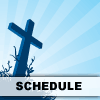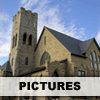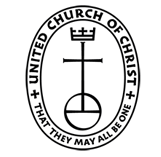God Saw That It Was Good – sermon on June 11, 2017
Genesis 1:1-2:4 In the beginning, God created the heavens and the earth. Now the earth was formless and empty, darkness was over the surface of the deep, and the Spirit of God was hovering over the waters. And God said, “Let there be light,” and there was light. God saw that the light was good, and separated the light from the darkness. God called the light “day,” and the darkness God called “night.” And there was evening, and there was morning – the first day. And God said, Let there be a vault between the waters to separate water from water. So God made the vault and separated the water under the vault from the water above it. And it was so. God called the vault sky. And there was evening, and there was morning – the second day.
And God said, Let the water under the sky be gathered to one place, and let dry ground appear. And it was so. God called the dry ground land, and the gathered waters were called seas. And God saw that it was good. Then God said, Let the land produce vegetation: seed-bearing plants and trees on the land that bear fruit with seed in it, according to their various kinds. And it was so. The land produced vegetation: plants bearing seed according to their kinds and trees bearing fruit with seed in it according to their kinds. And God saw that it was good. And there was evening, and there was morning – the third day.
And God said, Let there be lights in the vault of the sky to separate the day from the night, and let them serve as signs to mark sacred times, and days and years, and let them be lights in the vault of the sky to give light on the earth. And it was so. God made two great lights the greater light to govern the day and the lesser light to govern the night. God also made the stars and set them in the vault of the sky to give light on the earth to govern the day and the night, and to separate light from darkness. And God saw that it was good. And there was evening, and there was morning – the fourth day.
And God said, Let the water teem with living creatures, and let birds fly above the earth across the vault of the sky. So God created the great creatures of the sea and every living thing with which the water teems and that moves about in it, according to their kinds, and every winged bird according to its kind. And God saw that it was good. God blessed them and said, Be fruitful and increase in number and fill the water in the seas, and let the birds increase on the earth. And there was evening, and there was morning – the fifth day. And God said, Let the land produce living creatures according to their kinds: the livestock, the creatures that move along the ground, and the wild animals, each according to its kind. And it was so. God made the wild animals according to their kinds, the livestock according to their kinds, and all the creatures that move along the ground according to their kinds. And God saw that it was good.
Then God said, Let us make humankind in our image, in our likeness, so that they may rule over the fish in the sea and the birds in the sky, over the livestock and all the wild animals, and over all the creatures that move along the ground. So God created humankind in God’s own image, in the image of God he created them; male and female she created them. God blessed them and said to them, Be fruitful and increase in number; fill the earth and subdue it. Rule over the fish in the sea and the birds in the sky and over every living creature that moves on the ground. Then God said, I give you every seed-bearing plant on the face of the whole earth and every tree that has fruit with seed in it. They will be yours for food. And to all the beasts of the earth and all the birds in the sky and all the creatures that move along the ground – everything that has the breath of life in it – I give every green plant for food. And it was so. God saw all that God had made, and it was very good. And there was evening, and there was morning – the sixth day.
Thus the heavens and the earth were completed in all their vast array. By the seventh day God had finished the work he had been doing; so on the seventh day he rested from all his work. Then God blessed the seventh day and made it holy, because on it she rested from all the work of creating that she had done. This is the account of the heavens and the earth when they were created, when God made the earth and the heavens.
Sermon: God Saw That It Was Good by Rev. Doreen Oughton
“In the beginning!” – could there be a better opening line for our sacred text, our holy scriptures, our inspired Word of God? Genesis I tells the first story of the Creation of our world. Now some think the second story of Creation, the one that takes place in the Garden of Eden, is part two of the creation story, but it is actually a whole different story, told by different people in a different time. It’s important to remember that both stories are part of a larger story – the story of God’s engagement with us and with the world, and neither of them mean much apart from that larger story – the story told throughout scripture and through ancient traditions and through our own experiences. The bible has many different types of books within it – history and genealogy, laments and prophesies, folk wisdom, and poetry and songs – all meant to shape our faith and lead us closer to God.
What type of writing do you think Genesis I is? I would say it is poetry, and beautiful poetry at that. Here is another poem, by Mary Oliver, called Sleeping in the Forest: I thought the earth remembered me, she took me back so tenderly, arranging her dark skirts, her pockets full of lichens and seeds. I slept as never before, a stone on the river bed, nothing between me and the white fire of the stars but my thoughts, and they floated light as moths among the branches of the perfect trees. All night I heard the small kingdoms breathing around me, the insects, and the birds who do their work in the darkness. All night I rose and fell, as if in water, grappling with a luminous doom. By morning I had vanished at least a dozen times into something better. Now upon hearing that poem by Mary Oliver, did you find yourself arguing with it – “the earth doesn’t have skirts or pockets! – a stone doesn’t sleep! – how can there be nothing between her and the stars, why she would be burned up!?” Not likely. You listen differently, you let it enter into a different part of your brain – the right side instead of the left side. You stop analyzing and let yourself feel, or wonder, or connect. You know the author is saying something deep and true. It is the same with this beautiful story of creation.
Sarah Christmyer points out that many of the questions of our age are scientific. We want to know how the world began, when it come into being, and by what exact process? Which life form came first and how did the next being evolve? But the questions of the ancient world were different. They wanted to know who created, who is in charge? They wondered why are we here, and how do we relate to other beings? They asked why there is evil and whether anything can be done about it. Inspired by God, many people took on the task of shaping this faith narrative.
Genesis I is like an entrance hymn to the great drama that follows, and again, a piece of poetry that has deep meaning and truth. What I would like to do today is what I call a wondering sermon, going through the passage a little at a time, making little connections when I can, letting myself wonder, and inviting you to wonder along with me. If you have something you’d like to share, that would be wonder-ful.
What was there, in the beginning? Some say that God created everything out of nothing, but was there nothing but God in the beginning, according to Genesis?… There was a void, which is nothing, there is darkness, but there are also the waters. Over those waters the Spirit of God hovers, or moves. And then God speaks light into existence. I wonder about that light. Was it a small flicker that the darkness could not overcome? Did it slowly get brighter and brighter like the sun rising, or was it like brilliant fluorescents flipped on suddenly? Brian McLaren says that God’s light shines and calls all things from chaos, void and darkness toward order, fullness, light and life. I notice that in the poem, God adds the light, but keeps the darkness also. The light is declared to be good, but so is the darkness, isn’t it?
What associations do you make to light? to darkness? I think of light as awareness, and darkness as mystery. I think of light as active and darkness as restful. I like the idea of God moving out of restfulness, quiet and mystery to awakening and activity, but knowing there is time for rest and mystery again, and again, and again. Wonderings?
The next verses seem not so much about creating as about organizing, separating waters above from waters below, then the movement of the waters below until land appears and the seas are formed. I’m wondering about the waters above the dome, if there is a passageway to heaven so to speak, that includes moving through water. I think of birth as the entry into this world, and of course there is water there. Perhaps death is the soul’s entry into the world above the dome, through the waters there. Wonderings?
Next comes the filling of the void – the creation of vegetation, and later, the sea creatures, the sky creatures and the land creatures. It says over and over, “according to their kinds.” I wonder what that is meant to tell us. Maybe that it takes all kinds to fill God’s world? There seems to me an emphasis on the diversity – all created by God, all seen to be good, small and large, flying and swimming, buzzing and roaring. Wonderings?
And then finally comes the creation of human beings, male and female, in God’s image. I think because we think of Adam and Eve, we think of God starting with just one man and one woman, but this poem doesn’t say that. It says that God created humankind, in pew bible it is “man” but not a man. To me, this is the biggest wonder of all – in what ways are we made in God’s image? What do you think? Now the text that comes right after creation in God’s image is God’s instruction to be fruitful and multiply. Is that one of the ways we are like God, bringing more life into the world? God then says to subdue the earth, to have dominion over all the other creatures. Is that one of the ways, that we were created to have authority?
It is interesting to me how reactive I can be to the language of authority – rule over, subdue, have dominion. It feels dangerous, and I think that we all know it can be, depending on the intent and heart of those in authority. But this authority was and is supposed to be like God’s – not exploitive, not selfish. I think it was meant to give us power to continue to create – to add more fullness and order and life and light, all while keeping the integrity of the goodness of God’s creation. Good rulers protect and provide; they strive for peace and prosperity for their subjects, all their subjects. Think of the ways we have honored God with our authority – the medical and agricultural advances we’ve made, the creative ways we can get water to deserts, can feed people in the places where nothing grows, clean up messes. And think of the ways we have dishonored God with our authority – making messes, exploiting the environment, mining it of its treasures in ways that scar the earth, harming and enslaving animals, polluting the seas and the skies. Wonderings / musings?
Another way I think we are created in the image of the Triune God is that we are meant for community, for relationship. I love how God says, “in our image.” I wonder if self-awareness or consciousness is another divine quality, or perhaps that is misguided arrogance to assume that only humans have such awareness. How do I know what a tree knows, or what the sea is aware of, or whether the earth can remember me? I do believe that the pulse of God is in every bit of creation.
I tend to assume the ways we are made in God’s image are of a spiritual or abstract nature. Despite the cartoon presentations of God as the old bearded guy, in my left brain, I don’t conceive of God as having a body like ours, except, of course, for God’s incarnation in Jesus. But J. Philip Newell asserts that our physicality is indeed one of the ways we are created in God’s image. He says that we live according to the spirit in our bodies; that spirit and body are connected. He sees the soul as reflecting the image of God, and the body reflecting the image of the soul. I think of the Christian understanding of Sacraments (Communion and Baptism) as visible expressions of invisible grace. I think he is saying something similar. Any more musings about how we are created in God’s image?
And finally, we get to the seventh day, when God’s work is finished – the heavens and earth are completed in their vast array, and God rests. Here is what I wonder about with this passage – what did God do on the eighth day? Are there other worlds that God set about enlightening and organizing and filling? Again, this poem is the entrance hymn to the great story, and God continued to be engaged with this world – inspiring, creating, calling us to greater and greater enlightenment, divine-like dominion, relationship, dare I say partnership? There is still darkness, and I think of it as pure potential. It will always be with us – restfulness and mystery, more to explore, to remember, to create. God saw, and may we see also, that all of it was good, indeed it was very good. Amen.








